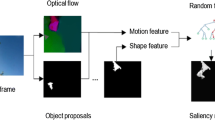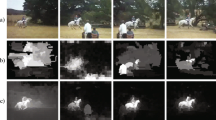Abstract
Detection of salient object sequences from video data is challenging when the salient object changes between consecutive frames. In this study, we addressed the salient object sequence rebuilding problem with video segment analysis. We reformulated the problem as a binary labeling problem, analyzed the potential salient object sequences in the video using a clustering method, and separated the salient object sequence from the background by applying an energy optimization method. Our proposed approach determines whether temporal consecutive pixels belong to the same salient object sequence. The conditional random field is then learned to effectively integrate the salient features and the sequence consecutive constraints. A dynamic programming algorithm was developed to resolve the energy minimization problem efficiently. Experimental results confirmed the ability of our approach to address the salient object rebuilding problem in automatic visual attention applications and video content analysis.
Similar content being viewed by others
References
Borji A, Itti L. State-of-the-art in visual attention modeling. IEEE Trans Pattern Anal Mach Intel, 2011, 35: 185–207
Ma L, Chen L, Zhang X J, et al. A waterborne salient ship detection method on SAR imagery. Sci China Inf Sci, 2015, 58: 089301
Liu T, Yuan Z J, Sun J, et al. Learning to detect a salient object. IEEE Trans Pattern Anal Mach Intel, 2011, 33: 353–367
Liu T, Zheng N N, Yuan Z J, et al. Video attention: learning to detect a salient object sequence. In: Proceedings of the International Conference on Pattern Recognition, Tampa, 2008. 1–4
Feng J, Wei Y, Tao L, et al. Salient object detection by composition. In: Proceedings of the IEEE International Conference on Computer Vision, Barcelona, 2011. 1028–1035
Yang C, Zhang L, Lu H, et al. Saliency detection via graph-based manifold ranking. In: Proceedings of the IEEE Conference on Computer Vision and Pattern Recognition, Portland, 2013. 3166–3173
Santella A, Agrawala M, Decarlo D, et al. Gaze-based interaction for semi-automatic photo cropping. In: Proceedings of the SIGCHI Conference on Human Factors in Computing Systems, Montr´eal, 2006. 771–780
Chen L Q, Xie X, Fan X, et al. A visual attention mode for adapting images on small displays. Multim Syst, 2003, 9: 353–364
Rother C, Bordeaux L, Hamadi Y, et al. Autocollage. In: Proceedings of the International Conference and Exhibition on Computer Graphics and Interactive Techniques (SIGGRAPH), Boston, 2006. 847–852
Jiang H, Wang J, Yuan Z, et al. Automatic salient object segmentation based on context and shape prior. In: Proceedings of the British Machine Vision Conference. Durham: BMVA Press, 2011
Jiang H, Wang J, Yuan Z, et al. Salient object detection: a discriminative regional feature integration approach. In: Proceedings of the IEEE Conference on Computer Vision and Pattern Recognition, Portland, 2013. 2083–2090
Zhao Y, Lu S J, Qian H L, et al. Robust mesh deformation with salient features preservation. Sci China Inf Sci, 2016, 59: 052106
Wu X M, Du M N, Chen W H, et al. Salient object detection via region contrast and graph regularization. Sci China Inf Sci, 2016, 59: 032104
Comaniciu D, Ramesh V, Meer P. Real-time tracking of nonrigid objects using mean shift. In: Proceedings of the IEEE Conference on Computer Vision and Pattern Recognition, Hilton Head Island, 2000. 142–149
Wei Y, Sun J, Tang X, et al. Interactive offline tracking for color objects. In: Proceedings of the IEEE International Conference on Computer Vision, Rio de Janeiro, 2007
Zhang G, Yuan Z, Zheng N N, et al. Visual saliency based object tracking. 1111In: Proceedings of the Asian Conference on Computer Vision. Berlin: Springer, 2009. 193–203
Liu D, Chen T. A topic-motion model for unsupervised video object discovery. In: Proceedings of the IEEE Conference on Computer Vision and Pattern Recognition, Minneapolis, 2007
Yun X, Jing Z L, Xiao G, et al. A compressive tracking based on time-space Kalman fusion model. Sci China Inf Sci, 2016, 59: 012106
Yang Y X, Yang J, Zhang Z X, et al. High-speed visual target tracking with mixed rotation invariant description and skipping searching. Sci China Inf Sci, 2017, 60: 062401
Doucet A, Freitas N, Gordon N. Sequential Monte Carlo Methods in Practice. Berlin: Springer, 2001
Lafferty J, McCallum A, Pereira F. Conditional random fields: probabilistic models for segmenting and labeling sequence data. In: Proceedings of the International Conference on Machine Learning. San Francisco: Morgan Kaufmann Publishers, 2001. 282–289
Shi J, Malik J. Normalized cuts and image segmentation. IEEE Trans Pattern Anal Mach Intel, 2000, 22: 888–905
Blake A, Rother C, Brown M, et al. Interactive image segmentation using an adaptive GMMRF model. 1111In: Proceedings of the European Conference on Computer Vision. Berlin: Springer, 2004. 428–441
Sun J, Zhang W, Tang X, et al. Bi-directional tracking using trajectory segment analysis. In: Proceedings of the IEEE International Conference on Computer Vision, Beijing, 2005
Zhang Y, Su A, Zhu X, et al. Salient object detection approach in UAV video. In: Proceedings of the 8th International Symposium on Multispectral Image Processing and Pattern Recognition. Bellingham: SPIE Proceedings, 2013. 8224
Acknowledgements
This work was supported by National Key RD Program of China (Grant No. 2016YFB100 1001), National Natural Science Foundation of China (Grant No. 61603022), and China Postdoctoral Science Foundation and Aeronautical Science Foundation of China (Grant No. 20135851042).
Author information
Authors and Affiliations
Corresponding author
Rights and permissions
About this article
Cite this article
Liu, T., Duan, H., Shang, Y. et al. Automatic salient object sequence rebuilding for video segment analysis. Sci. China Inf. Sci. 61, 012205 (2018). https://doi.org/10.1007/s11432-016-9150-x
Received:
Accepted:
Published:
DOI: https://doi.org/10.1007/s11432-016-9150-x




